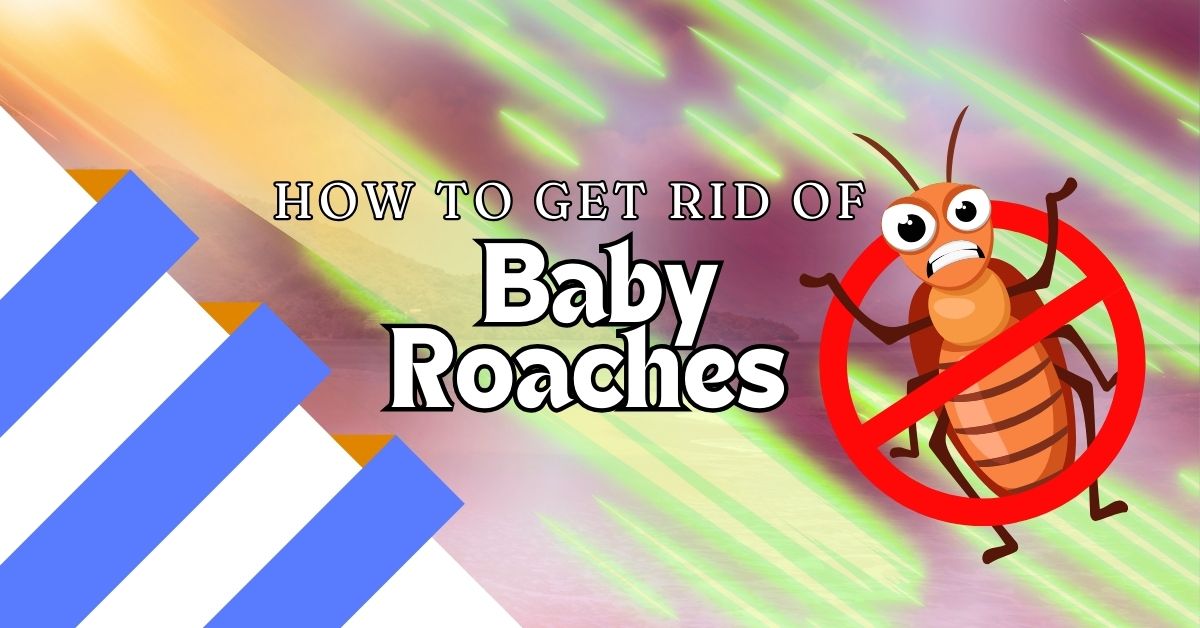Roaches are one of the most unwelcome pests you can find in your home, and their presence often starts with baby roaches. Baby roaches are the first signs of a larger infestation brewing, and if not addressed quickly, they can grow into a significant problem. Learning to identify and eliminate baby roaches is key to keeping your home clean, safe, and roach-free.
In this comprehensive guide, we’ll explain what baby roaches are, how to identify them, and the 5 most effective ways to get rid of them. Additionally, we’ll cover tips on preventing future infestations to ensure your home remains pest-free.
1. What Is a Baby Roach?
A baby roach is the juvenile form of a cockroach, emerging after hatching from an egg case called an ootheca. They are also referred to as nymphs, and they go through several stages of development before becoming adults. These young roaches are small, but they grow rapidly, shedding their exoskeleton multiple times as they mature.
Unlike adults, they do not have fully developed wings, and they tend to be lighter in color. Depending on the species, baby roaches may appear white or gray right after molting, only to darken as their outer shell hardens. Although tiny, baby roaches are a warning sign that an infestation has already started, as adult female roaches can produce dozens of eggs at once.
2. How to Identify a Baby Roach
Identifying a baby roach is essential for early intervention. They are typically smaller in size, usually around 1/8 to 1/4 inch long, and are wingless. Their size and lack of wings can sometimes make them easy to confuse with other pests, such as beetles or bed bugs, but their distinguishing features include:
- Oval-shaped bodies with flat exteriors.
- Six long legs that help them scurry quickly across surfaces.
- Antennae that are much longer than their bodies, aiding in navigation.
- Dark brown or reddish-brown color, depending on the species.
You might also notice baby roaches in moist, warm areas, such as kitchens, bathrooms, or basements. Since they prefer darkness, you’re more likely to spot them at night when they are most active.
3. Life Cycle of Baby Roaches
Understanding the life cycle of baby roaches is crucial for knowing how to eliminate them effectively. Cockroaches have a three-stage life cycle: egg, nymph (baby roach), and adult.
Egg Stage
Adult female roaches produce egg cases, or oothecae, which can contain up to 50 eggs per case depending on the species. These egg cases are deposited in hidden, sheltered areas and hatch within a few weeks.
Nymph (Baby Roach) Stage
Once the eggs hatch, the baby roaches emerge as nymphs. Nymphs resemble miniature versions of adult roaches but are smaller and lack wings. Over several weeks, nymphs undergo a series of molts, shedding their exoskeleton to grow larger with each stage.
Adult Stage
After completing several molts, the nymphs reach adulthood. Adult roaches are fully developed, including wings (depending on the species), and can reproduce, leading to more eggs and, consequently, more baby roaches.
The entire life cycle of a roach can take anywhere from a few months to a year, depending on environmental conditions and species. This rapid reproduction is why early detection of baby roaches is crucial.
4. Signs of a Baby Roach Infestation
A single baby roach sighting can indicate a larger roach infestation. Here are common signs that your home might be dealing with baby roaches:
1. Roach Droppings
Baby roaches, like adult roaches, leave behind droppings that resemble tiny black or brown specks. These can often be found in corners, behind appliances, or near food sources.
2. Shed Exoskeletons
As young roaches grow, they molt and leave behind their exoskeletons. Finding these shed skins around your home is a strong indicator of an active infestation.
3. Egg Cases
Seeing small, brownish egg cases (oothecae) around your home is a clear sign that roaches are reproducing. These cases are often found in dark, hidden areas like under furniture or inside cabinets.
4. Foul Odor
Roaches, including their babies, emit a musty or oily smell, especially in larger infestations. If you notice this odor in certain areas of your home, it could mean roaches are present.
5. Top 5 Methods to Get Rid of Baby Roaches
If you’ve identified a baby roach infestation, it’s time to take action. Here are 5 effective methods to eliminate them and prevent their return.
1. Use Roach Baits
Roach baits are one of the most effective ways to get rid of both young roaches and adults. The baits contain poison that the roaches eat and carry back to their colony, killing others in the process. Place baits near areas where you’ve seen young roaches, such as under sinks, in cabinets, and along baseboards.
2. Apply Insect Growth Regulators (IGRs)
IGRs prevent them from reaching adulthood, stopping the reproduction cycle. These products disrupt the molting process, effectively killing nymphs before they can become adults. You can use IGRs in combination with other roach control methods for maximum impact.
3. Seal Cracks and Entry Points
Roaches can enter your home through small cracks and gaps in walls, windows, and doors. To prevent more baby roaches from entering, seal any potential entry points using caulk or weatherstripping. This method helps keep roaches from breeding inside your home.
4. Keep Your Home Clean
Roaches are attracted to food and moisture. Keeping your home clean is one of the best preventive measures. Regularly vacuum, wipe down surfaces, and store food in airtight containers to avoid attracting roaches. Cleaning also removes any crumbs or spills that may feed a developing infestation.
5. Call a Pest Control Professional
If you’re dealing with a large infestation, calling a professional exterminator might be necessary. Pest control experts can use stronger treatments and techniques to eradicate them and ensure that they don’t return.
6. Where Do Baby Roaches Come From?
Roaches are highly adaptable creatures that can thrive in many environments. They often appear after adult roaches have laid their egg cases in hidden, moist areas. These can include:
- Cracks in walls or under appliances.
- Dark corners of cabinets, bathrooms, or basements.
- Behind large kitchen appliances, such as refrigerators and ovens.
Roaches tend to breed in warm, humid conditions, so kitchens and bathrooms are common breeding grounds. If these areas are not kept clean and dry, they become prime locations for roaches to lay their eggs.
7. Are Baby Roaches Dangerous?
While they may look less threatening than their adult counterparts, they still pose significant health risks. Roaches, including their nymphs, can carry bacteria like Salmonella and E. coli, which can contaminate food and surfaces. They are also known to trigger allergic reactions and asthma attacks, particularly in children and sensitive individuals.
Additionally, the presence of them is a clear indication of an infestation, which can worsen over time if not treated. Therefore, eliminating baby roaches as soon as they’re detected is crucial to protecting your home and health.
8. How to Prevent Baby Roach Infestations
Prevention is key when it comes to avoiding their infestation. Here are some practical tips to keep your home roach-free:
1. Clean Regularly
Ensure that floors, countertops, and other surfaces are free from crumbs and food debris. Roaches are attracted to even the smallest food particles.
2. Eliminate Moisture
Roaches thrive in damp environments. Fix any leaks in pipes or faucets, and ensure your home is well-ventilated to reduce moisture levels.
3. Seal Food Properly
Store food in sealed containers and avoid leaving pet food out overnight. Roaches are drawn to open food sources, and preventing access will reduce their interest in your home.
4. Declutter Your Home
Roaches love hiding in cluttered areas. Declutter your home to eliminate potential hiding spots and make it easier to spot any signs of an infestation.
5. Inspect Your Home Regularly
Conduct regular inspections of your home, especially in areas where roaches are likely to breed, such as basements, kitchens, and bathrooms. Early detection can help you address the problem before it worsens.
Wondering how to spot these pests early? Check out 5 Ways to Identify a Baby Cockroach in Your Home for quick tips! Link
Conclusion
They may seem small, but they are a clear warning sign of a developing infestation. By learning how to identify, eliminate, and prevent baby roaches, you can protect your home from a larger problem. Using effective methods like roach baits, sealing cracks, and keeping your home clean will go a long way in controlling and preventing roaches.
If you suspect a significant infestation, consider reaching out to a pest control professional for effective extermination. With the right approach, you can ensure your home stays pest-free and safe for you and your family.
FAQs About Baby Roaches
- What does a baby roach look like?
- They are small, oval-shaped, and wingless, with a dark brown or reddish-brown color.
- How fast do baby roaches grow?
- They molt several times before reaching adulthood, which can take a few weeks to a year, depending on the species.
- Are baby roaches harmful?
- Yes, They can carry bacteria and trigger allergies, making them a health hazard.
- What should I do if I find baby roaches?
- Use roach baits, seal cracks, and keep your home clean. If the problem persists, contact a pest control professional.
- Where do baby roaches hide?
- They often hide in dark, moist areas, such as under appliances, inside cabinets, and in bathroom corners.
- Can baby roaches reproduce?
- No, they cannot reproduce until they reach adulthood, but they will eventually grow into adults capable of laying eggs.
- How do I prevent baby roaches?
- Keep your home clean, store food properly, fix leaks, and declutter areas where roaches could hide.
- Are roach traps effective against baby roaches?
- Yes, roach traps can catch both baby and adult roaches, helping to reduce the infestation.
- Can baby roaches survive without food?
- They can survive without food for a few days to weeks, but they need water to live.
- How many baby roaches can one female produce?
- A female cockroach can lay an egg case that contains up to 50 eggs, which means dozens of young roaches can emerge from one ootheca.

Joseph Bush is a seasoned writer and researcher with over 7 years of experience covering a wide range of general topics, from lifestyle and technology to business and current events. He is dedicated to producing fact-checked, reader-friendly content that informs, engages, and empowers readers.
Throughout his career, Joseph has followed strict editorial guidelines, relied on reputable sources, and ensured every article meets the highest standards of accuracy and clarity. His expertise spans multiple fields, allowing him to explain complex topics in a way that’s easy to understand.
Passionate about continuous learning, Joseph stays updated on industry trends and best practices to deliver trustworthy, well-rounded insights. Readers can rely on his work for its credibility, depth, and real-world relevance.




